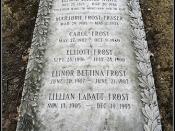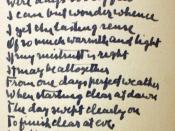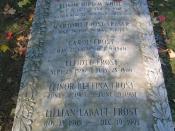"Home Burial" is a long narrative poem told in Robert Frost's conversational, very free blank verse. This means that the general structure of the lines is unrhymed iambic pentameter -- the same meter that much of Shakespeare's work is written in -- which classically consists of five pairs of alternately stressed syllables, with the stress on the second syllable of each pair; a pure example would be the second line of this poem, "BeFORE/ she SAW/ him, SHE/ was STAR/ing DOWN". However, there are few lines in Frost's poem which are metrically this pure, for the simple reason that people really don't talk like that, and Frost is attempting to give the impression of speech within the constraints of poetry.
The meter is important in this poem, because it gives "Home Burial" a formalism and at the same time a straining away from that formalism that is echoed in the poem itself.
In this case the poem revolves around the formalism that surrounds our public display of grief, versus the ragged and anguished healing process that must be done from within.
The unnamed couple in this poem have lost a baby to death. The mother grieves openly, and it could be said that she has never recovered from this loss; bereaved parents never forget, but most people in this position gradually work out a way of dealing with their grief, and go on with their lives. This the young mother cannot do. The baby is buried in the family graveyard which is visible from an upstairs window of their house. Every time the mother passes the window, her grief wells up anew.
But another emotion wells up as well -- anger and bitterness at her husband, which is at first unexplained. Our first intimation of the rift...


